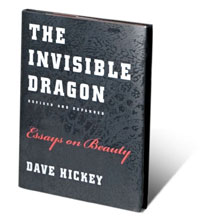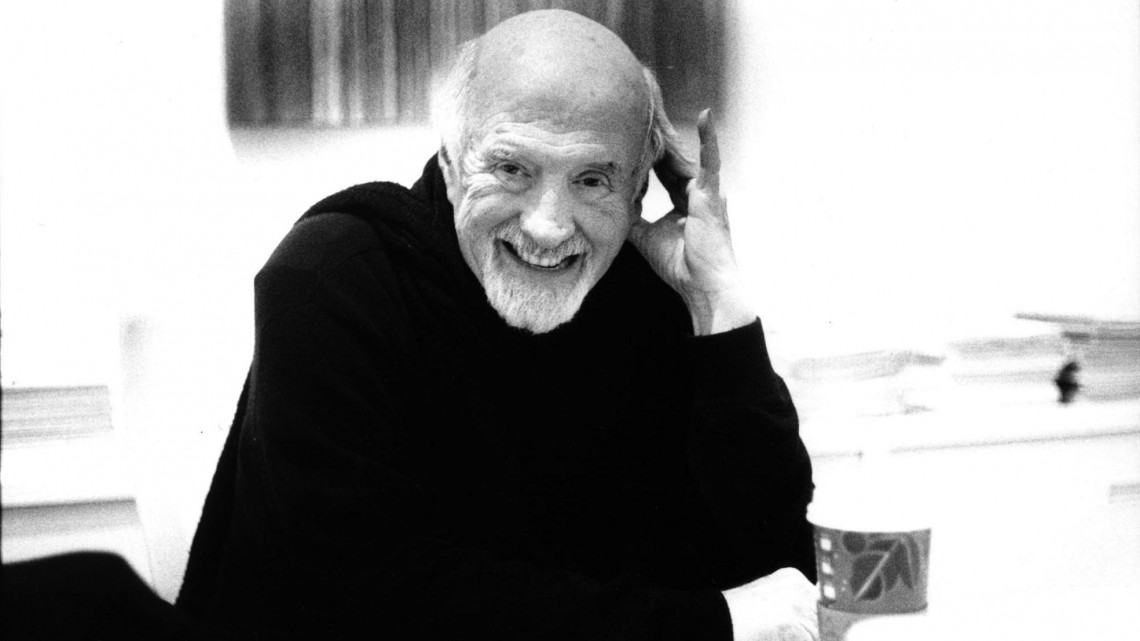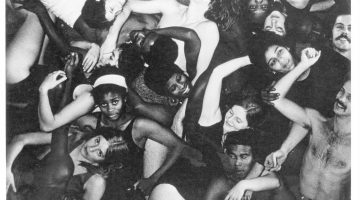Third Morning: Being Hit by a Soft Buick
Mid-morning phone call: “Jarrett—Dave. I’m going to leave tomorrow because I’m not having any fun. But I thought of some more things about art writing that could really save you some time so come over today when you have a chance.”
The biggest problem when I started writing criticism was transitions. “How does it get from here to there?” Gradually I read enough to realize that you don’t use them. No transitions. What you do is what I call a “jump shift.” In an art essay, I will start off with some sort of conversational anecdote and it will amount to about three hundred words, then you jump shift. An essay I was working on once started off with a little narrative about being in Julian Schnabel’s studio while they were tearing out the window to move out a 30-foot painting. Julian is directing everyone with his hands in the air and one of the working guys turns and says, “I bet Julian was an asshole in high school.” If you build that up and give it the time to create a little mise-en-scène, then you can just put a dot at the end and start again cold: “Julian Schnabel was born in Brooklyn, New York in April, 1951.” Then you go into that if you have that first hook nailed. My trick is to write paragraphs—don’t worry about where they go or if they go. After I have paragraphs I put them in order: here’s the narrative, here’s the hook, here’s the lede, here’s the jump shift—it’s a little train that goes along and you find the place to hook in another two paragraphs, then it’s the end. That means you are developing these little groups of leitmotifs. If you try to write it rationally, it will sound stupid because it’s not rational. It’s a set of waves. What I spend a lot of time on is just keeping it close to the ground, so we can go through this, we can go through Julian’s background, we can go through the rise of neo-expressionism and get to the place I was ultimately going: Julian’s career as a movie director, for which he was rehearsing when he was moving the painting through the window. That was the sort of loose hook that was there—and I’ll write it up one of these days, maybe—so I’m sorta going there and I’m sorta starting here. But mostly, if you write good paragraphs, you don’t need a transition, you can jump.
You reference John Ruskin a lot, who would write endless, paragraph-long sentences, so what do you see that needs to be in a paragraph to make it a complete unit?
Well I agree with Henry James who said the paragraph is the basic unit of writing—James’s paragraphs are a bit more portly than mine are, since I believe in the nested theory that eight bars of music is: statement, restatement, release, return; and twenty-four bars of music is: statement, restatement, release, return. So you’re almost trying to write the essay in each paragraph starting from a different point of view. But the thing is to write good paragraphs, and what you want is a good stop at the end of the paragraph, because if it stops well you can go anywhere from there. And you want a good lede, like in any story. The trick in a paragraph, I think, is that they are like sonnets in the sense that they have pivots, called “voltas” in a sonnet. There is a place in every paragraph where it turns. You start out here and you end up there in a slightly more skewed position. Three-fifths into a paragraph it better start turning—something better start happening. Same thing applies to the essay—three-fifths into the essay it better start turning. What imposing a rational structure on things (and Arthur Danto was the main offender in this infelicity) is that the marching prose just soaks into the soil. You have to go back to the visible as much as possible. My preference—which most critics ignore—is to spend a lot of time actually describing the work. If you can describe the work then you have said what you have to say about the painting. You can presume that you are moving right along. So we have the scene in Julian’s studio, then you have lots of background—what an asshole Julian was in high school in Houston, where I first met him. I mean he was not really mean; he was just who he is, he has a sense of drama—
You met Julian Schnabel when he was in high school?
No, I met him when he was out of high school and hanging around Houston trying to be an artist. Julian was trading his crap to all of his friend artists for their art, and I’m sure they threw it all away—it looked like crap—but I’m sure the ones that held them are very happy. So: here is your lede, here is your backstory—such that you need to fill in historical things—here is your description of the work, and if you can’t get out from those three points you’re in trouble! It sounds a lot more mechanical than it is. A lot of it is prosody and instinct. Sometimes I don’t do it at all, but in general I try to start off with that thing I suggested to Peter Schjeldahl—”the lady standing next to me looking at the Kiefer blew her nose.”
When it comes to that set-up, the conversational lede, the biographical stuff, and then the description, how do you connect the biographical to the descriptive?
It will connect because you say it does. The narrative pushes it up. You’re the boss. That is what you discover, that is why you don’t worry about transitions. If it’s not there, the words will put it there and you won’t have to do all the shit Arthur Danto does. I think it’s fairly important to make your preferences clear; I’ve written essays where I’ve said, “In my universe I don’t like this art. But in this universe I’m going to tell you how it might be good.”
What do you think of the personal essay as a form? Is “art criticism” something else?
I mostly write personal essays. I find them much more flexible. I really learned how to do it when I was writing slick magazine profiles on celebrities—how do you profile a celebrity? where do you put in their background? where do you put in their performance—how do you arrange things like that, without having to say “thus” or “because” too much, because you shouldn’t do that. Better to describe Roger Miller changing clothes 10 times before a show.
The logic of the celebrity profile seems to be the “up close and personal,” something more than the public face everyone knows.
Bob Christgau used to say, “You are not the celebrity’s friend, you are the reader’s guy.” I agree. You are noticing the socks with the holes in them and the bottles of cognac and whatever is around. I think you will find when you start doing this, it’s like dressing a set, that you’ll put in the things you want, like how in Julian’s apartment there is a lot of North African stuff, but like Jeff Koons, strangely enough, nothing is funny, Julian has no sense of humor. There are hijinks, that kind of clunky “oh I’m going to bump into you on the school yard” stuff but there’s not much there. I actually think that by going into the movies Julian saved himself—his movies are very nice. That is because, I think, Julian’s temperament is Diaghilev’s—it’s the organizer, it’s the guy that is casting the parts. He was always trying to make a movie for himself, which purportedly he did in Basquiat (1996). But how and where that connects to the paintings would be the hard part. If I were writing this essay in my imagination, I would basically call the paintings “set dressing.”
In what ways are figurative language—metaphors—useful or dangerous for describing art?
Well, I wrote a piece about Lynda Benglis’s big pour pieces that come out of the wall, and I ended up having to say about the same things about Robert Gober’s legs coming out of the wall—they are about a natural world bifurcated by industry. I think that is right in both cases. I’m really an “everyday language” person, so if I start by saying, “The solution proscribed in this case . . .” I would say, “Would be a big dose of talent.” You don’t send out for figurative expression, it is forced out of the vocabulary in which you’re writing. It just rises up. I think metaphors are forced up out of the prose.
There was something you wrote about the Primary Atmospheres show, where you say the object’s relationship to its form is that of aspic to its mold, which I thought clicked a lot of evocative stuff together in a very simple way.
That is pretty much the idea, and it’s a version of the idea I was talking about with Jasper Johns: why does Jasper use letters and numbers and targets? Well, first because they are forms that have no originals and I think Jasper liked that, but, most importantly, they are real stupid, and stupid nearly always pays off in that sense.
There is something he said to Leo Steinberg about the targets, that he uses them because they are something your mind “already knows,” which is the same thing.
Right, and I think that a lot of Jasper’s iconography is just an excuse to make sexy surface paintings. I think children will be wondering about whether the target is an asshole for the rest of this century—and in Lari Pittman it occasionally is—but I don’t think it is in Jasper’s case. I like the logic of the flags: “The thing about the flag is not who made it but who salutes it”—“The best thing about the target is that you aim at it.” You move the whole presence of the object into its extension in space. To go back to writing: I think you keep your promises. If what you’re doing is all out of shape, the reason is probably that there is a promise you made up at the top that you are not keeping at the end. The fat lady in the second sentence must reappear if you’re writing literary prose. Everything should be accounted for. But what you do about picking the wrong artists—shit, I don’t know. I was talking about that Pistoletto piece, which was my first “big” essay, so I let it slide. That is why I find negative reviews much more difficult to write than positive reviews. I can figure out the conditions under which something might be good, but I can’t explain why anyone would make bad art. I don’t have a fucking clue!
When you get into the description part of it, you mainly talk about the physical object itself in a tight frame, as opposed to the exhibition as an entity.
If it is an exhibition I will usually pick out a typical object in the show. Nuance resides in the single occasion, so I think you’re better off just talking about one. This goes back to the advice of Paul Williams, the songwriter: “Never put more than one interesting line in a song.” And there is tendency to do that—you want to make everything gorgeous, but if it’s a good hook just let it emanate. If you’re being clear and grammatical don’t worry about boring—people can read clear and grammatical very rapidly. If you want to make it hard, make it beautiful and difficult. Except criticism is a craft and not an art.
You mainly write monographic pieces.
That is what I write lately. I have this very interesting problem now: this story I should have been writing for two weeks while I’ve been down here seeing stars and jaguars, which is this story on David Levinthal. It’s for the Smithsonian. There is a nice, simple, little “Smithsonian essay” to be written. But there is a much more complicated essay to be written about what happens when the stopped time in a toy and the stopped time in a photograph create the illusion of action—it’s like a double negative. That is a little more grown-up than the Smithsonian wants, but . . . There is also the argument to be made that “this is Western art because the size of the figure is related to the scale of the ground” so you can use a little bitty ground to make something look big. That seems simple enough, unless you have been to the Middle East or a Byzantine church—it’s hard to describe. Even so, I like to write about things that I like but that I don’t understand when I start. When I started writing I did learn some very basic rules, one of which is: don’t start writing until you are ready to start writing. The transition from typewriter to computer, which you have never suffered, was that, on a computer, you can just write and erase and write and erase, but it won’t get you there because you really need to wait until you have something to say. So—put it off.
Until you have to do it?
Yeah. Then you’re getting more money per hour and you’re not going to be boring. I can’t imagine writing boring stuff for a long time. I think the deadline pressure really helps periodical journalism. Were it not for that I would probably still be revising my first little essay.
Before you start writing do you envision how things go, like how the narrative works?
No, I envision random words—a kind of bouquet of possible meanings. “Turtle,” “veranda,” “enfilade,” or “mountain chickadee”—how they look.”
Descriptions?
“Taller than a dog”—just vigorous little shots at describing or observing the art. I remember I wrote a pretty good piece on Mary Heilmann—I’ve known her for years; I knew her when she lived in El Segundo (all my girlfriends are ranked up and down the beaches of Southern California). I decided that the most persuasive, imaginative image of “Mary Heilmann” would be the Norman Rockwell picture of the little girl sitting out in front of the principle’s office with a black eye and a big smile—that is Mary. She’s such a willful imp that she didn’t start painting until she was sure painting was dead. She was going around asking everyone, “Is painting dead?” Then, she started making paintings that have no lateral pressure—she was a ceramist—so all her paintings piss off at the edges, which is very effective of course.
All painters grow up learning discipline: “This is too much, this is too little, this goes in, this goes out, this should go flat”—all of these kinds of decisions. I always thought that Liz Murray had the ability to break every one of those rules. I don’t think she ever thought, “This shouldn’t stick out three feet,” whereas any normal person would. Liz was perfectly free, and I think that explains her prodigious production. She was really having fun. In a sane world she would be recognized at the greatest art comedian of the 20th century. The Carol Burnett of art.
How does humor and wit function in both your writing about art and the work of art itself?
I thought early on John Currin was humorous, now it just looks frat house. There is art like Ruscha’s that is witty, but wit is not going to get you a blowjob in New York. Personally, although I traffic in wit, I know that it doesn’t really help and that people don’t really like it. I come out of Alexander Pope and all of that ongoing ongoingness. So the idea of just lining all your little cars in the railroad yard and attaching them as they need to be attached is a pretty good strategy for me. I can’t remember the day, but I can remember the feeling when I got an assignment that I knew I could write! When you think, “I don’t know if I can write this,” or, “What am I going to write about Bachman-Turner Overdrive?” you’re dead. What I did with Bachman-Turner Overdrive, who fell somewhat short of valedictorians, was to invent a teenage companion, Norman, who was much hipper to childlike things, and I would take him theoretically on trips with me and he would keep me from getting too excited about Nils Lofgren or whatever was the latest pop of the day. There are thousands of devices. If the content is too personal, too much grounded in my experience, I’m much more comfortable going into the third person and writing it as “he.”

You did that for the introduction for the revised edition of Invisible Dragon.
And I did it in the last essay in my short story book. The essay was called Proof through the Night, which I regard as the last great title from the Star Spangled Banner—I was happy about that. Proof through the night, don’t we all need that? Also I have to tell you something else: one of the ways out of swanning narcissism, if worse comes to worse, is to quote yourself. You don’t say, “I thought . . .” you say, “I have a friend who thinks . . .” Then you have some calm distance—you don’t have to say who that person was. You really have a lot of options when you write, but that presumes that you have something in your mouth that you are chewing on, unlike that asshole at Princeton—he’s not chewing on anything. What I’m saying is: a good essay on art is not always a good argument, it is a good story with implications—that is what you learn writing celebrity journalism. You are writing a story with available materials, available light. I learned how to do that—an evening in a room with Jeff Beck isn’t as dazzling as you might think, but the interview was about Stratocasters. That is what Jeff Beck knows and loves so it was very sweet. Another real insight for me: I stopped taping interviews because I found that once I started using the tape recorder my eyes and ears shut off, like, “I’m going to trust the tape recorder on the table,” and you can’t do that. I write better than I transcribe, so I remember the voices.
You just need to understand that as you move on, you are not going to be any smarter than you are today. I’m not any smarter than I was when I was 23, but eventually I acquired the confidence that I was right. At first you think, “I think this, but everyone is going to hate me,” then as you grow you think, but “I’m right—fuck you!” That is a good feeling. It gives you more energy if you think you’re right about a certain kind of thing.
I don’t want to live in a world where everyone agrees, even if it is with me.
I don’t either! I do difficulty. If everyone loves it—I don’t. I really think that Andy Warhol moved into Valhalla by having his work largely misinterpreted. Barbara Rose still thinks the soup cans are ironic, on no evidence whatsoever. Just because she couldn’t get her mind around them not being ironic, just because she couldn’t see the residues of Mark Rothko amid the soup cans. Things like that can really fuck up the discourse. Like Wade Guyton, if you were old enough to have lived through the ‘70s, you don’t really want to look at those Wade Guyton printouts and think of the shit everybody was doing in 1972 and threw away. A lot of artists now are suffering from what I call the “Dolly Parton problem,” which she mentioned to me in her early days. She said: “The thing is, if you have big hits when you’re 19 and 20 years old, it’s really hard to change. You’ve got a bunch of disc jockeys saying: Doesn’t sound like Dolly!”
You were talking to her in the ‘70s, and she starts to transition into a pop idiom in the late-‘70s?
Mid-‘70s. I went on the last tour she took with Porter Wagner. It was kind of fun and kind of sad. They loved each other, not sexually, but they had been singing together for years and it’s hard to lose your harmony line. Dolly was really going somewhere. She’s an amazing songwriter and getting hugged by her is like being hit by a soft Buick. But the Dolly Parton problem is going to grasp all these young zombie abstractionists. Sooner rather than later they’re going to have to have a new idea . . .
Do you feel you got perceived in a certain stylistic way you tried to move away from?
No, I never tried to move away from it. I was really surprised, given the essays that I have written, that my accent and my home state would turn me into a monster. I’ve lost millions of dollars being from Texas, a place I detest, and I’ve always written about marginal, difficult artists—that is what I do. But show me to some academic feminist and she’s right down my throat. I don’t know why. Maybe I am a little sharp about academic footwear, but what do you want? Dull?
What do you think it is to bring theoretical texts into teaching artists? Is there a best way?
The writing that’s not about art is the best, because the stuff about art is mostly lame, and most art is lame. I’ve taught a lot of books: I taught Northrop Frye, who is good because he classifies narratives in terms of the protagonist’s control over the environment, so you start in the heroic mode where the protagonist has total control and you end up in the ironic mode where the protagonist turns into a beetle. It really helps kids sort out what they’re doing and where they are placing things. It also helps abstract painters to see that there is a kind of class system in abstract painting. You can do Mary Heilmann right off the beach, or you can do Philip Taaffe right out of the beauty shop. Once you see these categories it gives you more clarity.
You’ve written about a lot of artists that you know personally. Do you think that is useful or not useful?
Actually, it’s not useful at all. Artists are interesting people, there is no doubt about that, but they’re like poker players. If you know a poker player socially, you know one person—that ain’t the lady who plays poker with you. You know an artist as a person, but that ain’t necessarily the one who makes art—it’s a parallel reality. How someone as impudent as Ed Ruscha could have gone through life as such a courtly person—and he is a courtly person—don’t ask me. And there are a lot of things I’ve written about people whom I simply don’t like, but you don’t have to be nice to be good, and all that like-don’t-like shit just drips right away. I think that artists present themselves to the world very differently than they present themselves to their art. Maybe, if that were not the case, they wouldn’t be artists. You were asking me if my rough manner was a defense mechanism? Yes. Except for my wife and Dolly Parton, I like art better than people. I would also say your theatrical promiscuity is a defense mechanism as well. I tried it. It worked, but I could never corner Hannah Wilke.
Well, that is obvious. I would also say your theatrical promiscuity distances in the guise of being open.
I know exactly what you mean; we develop these things because we are embarrassed by this ridiculous, wimpy profession—the art world is just plain wimpy, the people are way more wimpy—so we theatricalize our little edge. Nauman does this too. I have always done the things I say I’ve done, but it doesn’t take a lot of years to do all the terrible things I’ve said I’ve done—it’s not like a major investment of time to fuck up a lot. You will notice there is a lot of Dave in this interview, but not much you can understand.



